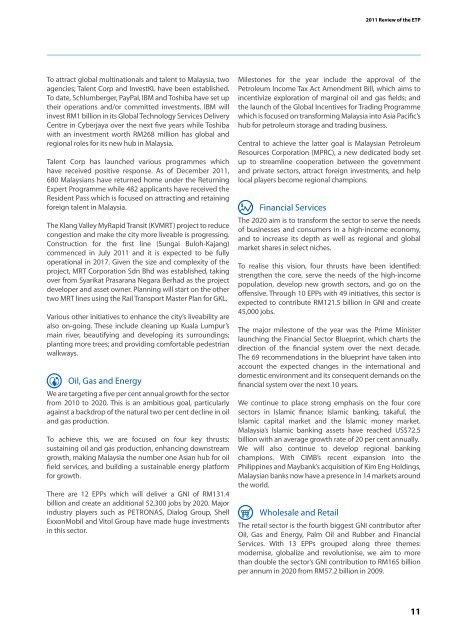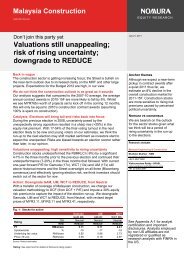Download PDF - ETP - Pemandu
Download PDF - ETP - Pemandu
Download PDF - ETP - Pemandu
You also want an ePaper? Increase the reach of your titles
YUMPU automatically turns print PDFs into web optimized ePapers that Google loves.
To attract global multinationals and talent to Malaysia, two<br />
agencies; Talent Corp and InvestKL have been established.<br />
To date, Schlumberger, PayPal, IBM and Toshiba have set up<br />
their operations and/or committed investments. IBM will<br />
invest RM1 billion in its Global Technology Services Delivery<br />
Centre in Cyberjaya over the next five years while Toshiba<br />
with an investment worth RM268 million has global and<br />
regional roles for its new hub in Malaysia.<br />
Talent Corp has launched various programmes which<br />
have received positive response. As of December 2011,<br />
680 Malaysians have returned home under the Returning<br />
Expert Programme while 482 applicants have received the<br />
Resident Pass which is focused on attracting and retaining<br />
foreign talent in Malaysia.<br />
The Klang Valley MyRapid Transit (KVMRT) project to reduce<br />
congestion and make the city more liveable is progressing.<br />
Construction for the first line (Sungai Buloh-Kajang)<br />
commenced in July 2011 and it is expected to be fully<br />
operational in 2017. Given the size and complexity of the<br />
project, MRT Corporation Sdn Bhd was established, taking<br />
over from Syarikat Prasarana Negara Berhad as the project<br />
developer and asset owner. Planning will start on the other<br />
two MRT lines using the Rail Transport Master Plan for GKL.<br />
Various other initiatives to enhance the city’s liveability are<br />
also on-going. These include cleaning up Kuala Lumpur’s<br />
main river, beautifying and developing its surroundings;<br />
planting more trees; and providing comfortable pedestrian<br />
walkways.<br />
Oil, Gas and Energy<br />
We are targeting a five per cent annual growth for the sector<br />
from 2010 to 2020. This is an ambitious goal, particularly<br />
against a backdrop of the natural two per cent decline in oil<br />
and gas production.<br />
To achieve this, we are focused on four key thrusts:<br />
sustaining oil and gas production, enhancing downstream<br />
growth, making Malaysia the number one Asian hub for oil<br />
field services, and building a sustainable energy platform<br />
for growth.<br />
There are 12 EPPs which will deliver a GNI of RM131.4<br />
billion and create an additional 52,300 jobs by 2020. Major<br />
industry players such as PETRONAS, Dialog Group, Shell<br />
ExxonMobil and Vitol Group have made huge investments<br />
in this sector.<br />
2011 Review of the <strong>ETP</strong><br />
Milestones for the year include the approval of the<br />
Petroleum Income Tax Act Amendment Bill, which aims to<br />
incentivize exploration of marginal oil and gas fields; and<br />
the launch of the Global Incentives for Trading Programme<br />
which is focused on transforming Malaysia into Asia Pacific’s<br />
hub for petroleum storage and trading business.<br />
Central to achieve the latter goal is Malaysian Petroleum<br />
Resources Corporation (MPRC), a new dedicated body set<br />
up to streamline cooperation between the government<br />
and private sectors, attract foreign investments, and help<br />
local players become regional champions.<br />
Financial Services<br />
The 2020 aim is to transform the sector to serve the needs<br />
of businesses and consumers in a high-income economy,<br />
and to increase its depth as well as regional and global<br />
market shares in select niches.<br />
To realise this vision, four thrusts have been identified:<br />
strengthen the core, serve the needs of the high-income<br />
population, develop new growth sectors, and go on the<br />
offensive. Through 10 EPPs with 49 initiatives, this sector is<br />
expected to contribute RM121.5 billion in GNI and create<br />
45,000 jobs.<br />
The major milestone of the year was the Prime Minister<br />
launching the Financial Sector Blueprint, which charts the<br />
direction of the financial system over the next decade.<br />
The 69 recommendations in the blueprint have taken into<br />
account the expected changes in the international and<br />
domestic environment and its consequent demands on the<br />
financial system over the next 10 years.<br />
We continue to place strong emphasis on the four core<br />
sectors in Islamic finance; Islamic banking, takaful, the<br />
Islamic capital market and the Islamic money market.<br />
Malaysia’s Islamic banking assets have reached US$72.5<br />
billion with an average growth rate of 20 per cent annually.<br />
We will also continue to develop regional banking<br />
champions. With CIMB’s recent expansion into the<br />
Philippines and Maybank’s acquisition of Kim Eng Holdings,<br />
Malaysian banks now have a presence in 14 markets around<br />
the world.<br />
Wholesale and Retail<br />
The retail sector is the fourth biggest GNI contributor after<br />
Oil, Gas and Energy, Palm Oil and Rubber and Financial<br />
Services. With 13 EPPs grouped along three themes:<br />
modernise, globalize and revolutionise, we aim to more<br />
than double the sector’s GNI contribution to RM165 billion<br />
per annum in 2020 from RM57.2 billion in 2009.<br />
11








